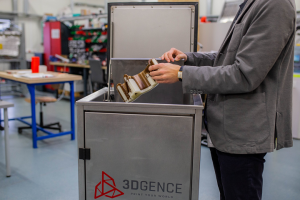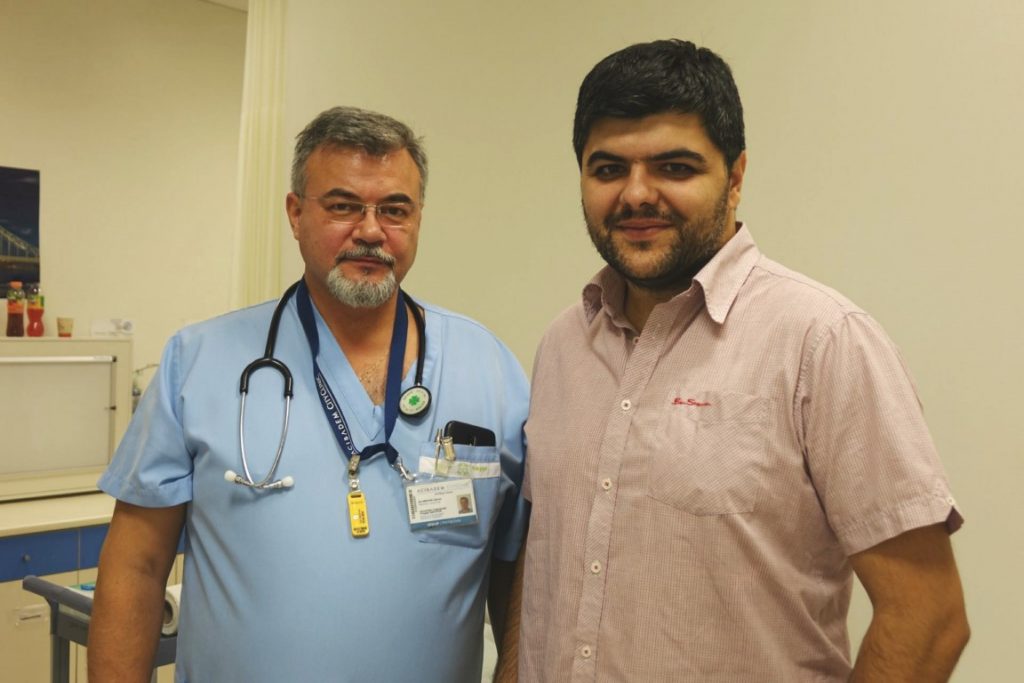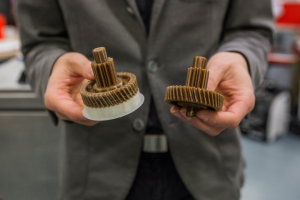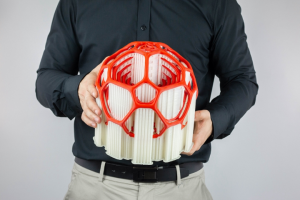3D printed rib implant saves a life at Tokuda Hospital, Bulgaria
Patient Receives a 3D Printed Rib for the First Time in Bulgaria
35-year-old Ivaylo Josifov was an active, healthy individual who thought he only had a case of tonsillitis when he went to the doctor recently. A chest X-ray, however, showed that he had a growth in the area of his fifth right rib. It was a congenital disease that could lead to the weakening of the chest and issues like difficulty breathing. Because of the risk that the growth could spread, the best option would be to remove the rib entirely and replace it with an implant. Josifov’s doctors decided to try something that had been done only a few times in the entire world before, and never in Bulgaria – to use 3D printing technology to create a new rib for their patient.
The doctors chose 3D printing because it could guarantee a perfect replica of the original rib shape, both in thickness and curvature. They started by scanning the original bone, then sending the scan to Bulgarian service bureau 3dbgprint. The service bureau prepared the file for 3D printing, adjusting it to be sure that it fit into the chest wall. 3dbgprint then 3D printed the implant using a 3DGence 3D printer.
“Our 3D printers ensure high 3D dimensional accuracy which was crucial in this particular medical procedure,” said Filip Turzyński, Quality Development Manager at 3DGence. “Individually designed rib model allowed for very accurate implementation of the new element in place of the removed bone. Replacing the missing rib with a 3D printed segment with the same shape, curve, width, and thickness was possible with the use of 3DGence 3D printer.”
The new rib was 3D printed using an FDA-approved flexible, durable polyamide.
“When we had the first model ready, we started working on its sturdiness,” said Georgi Tolev of 3dbgprint. “Each consecutive model was analyzed and improved until we attained the perfect 3D print of the rib.”
 Before the rib was implanted, 3 mm holes were drilled in it to facilitate broaching and proliferation of connective tissue. The implant was thoroughly sterilized, using ethylene oxide as well as gamma radiation and autoclave at 140ºC. The surgery took place at Tokuda Hospital, and the patient is back to excellent health.
Before the rib was implanted, 3 mm holes were drilled in it to facilitate broaching and proliferation of connective tissue. The implant was thoroughly sterilized, using ethylene oxide as well as gamma radiation and autoclave at 140ºC. The surgery took place at Tokuda Hospital, and the patient is back to excellent health.
Due to the success of the procedure, doctors are already planning new projects using 3D printed implants. Next, they plan to create an implant of three ribs attached to a sternum.
“This is a new era in thoracic wall reconstruction for patients with tumors that require bone-cartilage structures to be removed,” said Professor Minchev, Head of the Cardiothoracic Surgery Department at Tokuda Hospital. “The material used has proven tissue compatibility and the accuracy of reproduction allows for large chest wall resections and their single substitution with individually designed implants.”
Without 3D printing, doctors would have had a much more difficult time creating an implant that fit perfectly and matched the patient’s original rib. An ill-fitting implant could have led to pain and complications, possibly requiring additional surgery in the future. With 3D printing, however, it was possible to perfectly recreate the original rib, allowing the patient to recover quickly and go about his normal life.
Discuss this and other 3D printing topics at 3DPrintBoard.com or share your thoughts below.
3D Printing News Sliced, Nano Dimensions, Local Motors, AMUG, 3DGence, Fabrisonic
3DGence Introduces ESM-10 Soluble 3D Printing Support Material for PEEK and ABS Models
Polish 3D printer manufacturer 3DGence, a third wave 3D printing company, has just launched a new product that’s really cool: ESM-10 (Engineering Soluble Material), the first soluble support material for PEEK 3D prints.
“An introduction of the ESM-10 is a milestone not only for 3DGence but also for the entire 3D printing industry,” said Mateusz Sidorowicz, the Marketing Manager at 3DGence. “Soluble support filament for technical materials creates new opportunities, especially for industrial companies. Creating prints with advanced geometry and large dimensions is now easier.”
Before now, PEEK-friendly support materials cost a lot of money, and were pretty difficult to remove from prints. Most people were just using PEEK as a support material for PEEK. Depending on the grade this could cost $600 or more per Kilo and be difficult to remove as well. But ESM-10, just one in a series of advanced engineering filaments that are used to create complex 3D prints with necessary complex supports, uses a heated chamber – above 80°C, to be exact – to ensure the support structure’s stability for models made with both PEEK and ABS materials.
The ESM-10 support material, which can be easily washed out in a prepared water solution, is designed for technical applications and is compatible with the 3DGence INDUSTRY F340 industrial 3D printer.
While ESM-10 is recommended for ABS and PEEK model materials, this is not the case for PLA filament; it’s much better to use soluble materials like PVA or BVOH with the popular plastic.
ESM-10 is able to endure, as 3DGence puts it, “the temperature of the working chamber in which it can be printed,” and the material won’t clog up any hotends or recrystallize, since it can be 3D printed at higher temperatures. Because of its unique features, the soluble material can also be used as a support for prints made out of more technical materials where options like BVOH or PVA can’t be used.
In addition to its new ESM-10 support material, 3DGence has also introduced its SDS, short for Support Dissolving System: a circulation tank that was designed specifically for the purposes of dissolving the supports from 3D prints.
“SDS is dedicated to removing support structures from 3D prints made of PEEK or ABS. Its greatest advantage is that it eliminates the need for manually removing supports,” said Filip Turzyński, the Quality Development Manager at 3DGence. “Thanks to this solution we can be sure that the printed model will not be damaged in any way. In the automated rinsing process we can obtain a clean model free of supports, which is fully functional.”
 The SDS machine includes a large, actively heated working chamber, which has a total capacity of 55.2 liters, and also comes with a 36 x 36 x 28 cm basket for 3D prints that allows larger models to be totally immersed in a water solution in order to rinse away the supports. Both the heating system and the device’s insulation ensure that the temperature inside is well-suited to efficiently remove support materials.
The SDS machine includes a large, actively heated working chamber, which has a total capacity of 55.2 liters, and also comes with a 36 x 36 x 28 cm basket for 3D prints that allows larger models to be totally immersed in a water solution in order to rinse away the supports. Both the heating system and the device’s insulation ensure that the temperature inside is well-suited to efficiently remove support materials.
Users need to pour a dedicated chemical solvent into the SDS circulation tank, which will effectively dissolve the ESM-10 support material without causing any damage to the 3D printed model’s material. Because the water system is connected to the water pump, it’s very easy to fill and empty the SDS, and you can safely discharge the combined chemical solution and dissolved ESM-10 material into the sewage system once rinsing is complete.
This once again validates the space increasingly occupied by third wave companies who are going further than just the box. 3DGence is not looking at just the printer they’re looking at the materials, settings and even post-processing equipment to expand the makable. This kind of careful consideration will expand the sum total of the makable and increase what can be made using our technology.
Discuss this news and other 3D printing topics at 3DPrintBoard.com or share your thoughts in the Facebook comments below.
[Images provided by 3DGence]






